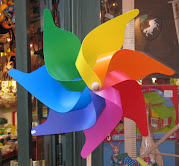 This morning we tweeted as part of worship - you can read our tweets at http://twitter.com/oikoumene. It was an interesting experiment, we did low tech tweeting with pencil and paper and I typed the tweets into the site in themed groups in free moments during the day.
This morning we tweeted as part of worship - you can read our tweets at http://twitter.com/oikoumene. It was an interesting experiment, we did low tech tweeting with pencil and paper and I typed the tweets into the site in themed groups in free moments during the day.
Tweets are of course just little things, fragments of communication, yet even in just 140 keystrokes you can say something meaningful, you can link to a photo or audio file, to an article or video. You can try to "hook" people, you can make statements and of course you can also preach and pray using the medium.
Today I tried to get people to tweet in four ways - first a tweet of confession of brokenness, after that a tweet of hope for just peace after hearing the assurance of forgiveness and listening to Isaiah 52, then a tweeted biblical reflection on Matthew 6 25-33 - the lilies of the field; and finally prayer tweets of intercession for peace and justice.
We had a group of people from the Danish churches so many of today's tweets were in Danish, others were in German, French, Swahili and Tagalog (I think ...) so I had an interesting time typing them up - especially as Twitter was painfully slow this afternoon.
I did not preach but as an invitation to the biblical reflection I took with me a small branch of a pink flowering prunus. The gospel reading we listened to - in French - was of the lilies of the field. Yesterday I read this moving and beautifully written article by Joji Sakurai on cherry blossom and transience as a source of strength. She wrote:
For the Japanese, it will be a particularly poignant sight. Even in normal times, the flowers are a cause for rejoicing tinged with sadness, because they fall at the moment of their greatest beauty. They are the embodiment of a notion that is central to Japanese culture — "hakanasa," a hard-to-translate word that conveys the fragility, or evanescence, of life.I was moved to learn that the cherry blossom is also the symbol of valour for the Samurai. this prompted me to think about how we so often have such grandiose plans for our projects - our peace-making and events too. Our work for a just peace today needs somehow to be like cherry blossom willing to bloom beautifully and then let go. Just-peace can never be about something set in stone. I believe in the little fragile things, in the arpilleras of the stitching peace exhibition, in the petals that gently fall and look like snow, in folk who find time to have a meal with one another and in the transience rather than in the permanence of our witness, in the God of small things. Like the cherry blossom, Christ too was at his most evanescent just before his life ended - how else can you read and understand his passionate words and actions, his foot washing in John's gospel, if it is not in some way about a vital fragile blossoming: "That all may be one".
If the blossom does not fall there will of course be no fruit. Only sacrifice bears fruit.
Here are two tweets written by someone at this morning's service, they sum up fragmentally but succinctly some of what I'm trying to say.
I grew up in blossom country in the Vale of Evesham, and thinking about the cherry blossom reminded me of A. E. Houseman's Loveliest of trees the cherry now ... which has its own strong intimations of mortality and celebration of nature. I like the idea of spring and winter almost being one in terms of the beauty, how the snow reminds of the springtime blossom. How sad that when I was studying it at school I never quite reached such gentle understanding of it. Now I can see how this deep human understanding of passing seasons and transience links east and west, north and south.
#IEPC Is 52:7 Mt 6:25 Transient lives contributing to the justice mercy & peace on earth
#IEPC Is 52:7 Mt 6:25 Transient blooms that bring everlasting beautiful memories
This evening coming home on the bus I realised that I shall never really be a systematic theologian but always a fragmentic theologian. Outside the main entrance to the Ecumenical Centre a prunus is in flower next to the white cross outside the chapel, it always makes me smile to see that in springtime, even on a wet grey morning like today. And seeing it reminded me of this which we sang in the chapel at the end of last winter, when spring was merely a vague promise, but nevertheless on the way:
“O make our barren trees to grow, our hands to blossom,
and let our lives bring forth such fruit that heals our neighbours’ grief and pain.”
It's by a Norwegian artist and hymn writer called Svein Ellingsen.
Poetry about blossom, thinking about the transience of blossom gives me strength, reminds me of the orchard in the garden at home and pure pleasure at beauty. It also offers a slightly subversive paradigm to my understanding, one that is glorious, mystical and filled with both pain and perfume. It is good to be a fragmentic theologian, a source of tearful strength.






1 Comment:
Haven't hung out in the blogosphere for a while. This is a brilliant post to lure me back. Hope all is going well for you
Post a Comment